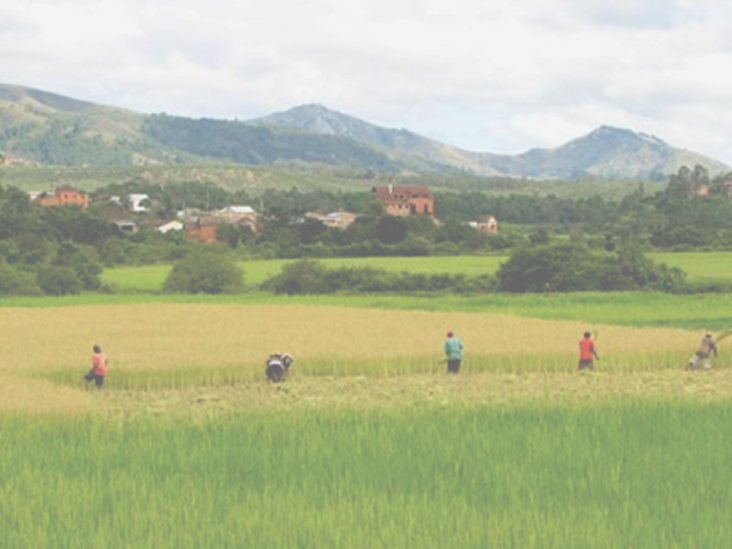
Madagascar Food for Peace development programs use a multi-sector approach to address malnutrition. Over 30 different activities are implemented at the community level and can be grouped into 3 components: health and nutrition, agriculture and livelihood and disaster mitigation and preparedness. Cross-cutting themes include women empowerment and governance.
WHAT’S GOING ON IN A COMMUNITY/FOKONTANY?
Health and Nutrition Activities
Growth Monitoring Promotion (GMP) – GMP activities regularly document young children’s weight and height counsel parents to improve growth and prevent malnutrition. The purpose of the GMP activities is to prevent stunting through timely and early detection of malnutrition.
Community Health Clinic Referrals – Community health volunteers refer children identified as having severe acute malnutrition to community health clinics (CSBs in French). The CSB is the most local formal health facility available and provides treatment for diseases and therapeutic care for severely acute malnourished children. The purpose of these referrals is to ensure children with severe acute malnutrition receive the professional medical care only CSB staff can provide.
Supplementary Feeding for Mothers and Small Children: This program distributes healthy rations to pregnant and lactating women as well as children under the age of 2 to supplement their diets. The purpose of this activity is the prevention of malnutrition among mothers and children during the first 1000 days (from conception to 2 years of age), when deficiencies can cause irreversible damages to infant physical and psychological growth.
Cooking Demonstrations are organized by community health volunteers to promote healthy dietary practices using local ingredients. The purpose of the demonstrations is to share mothers’ experiences on preparing nutritionally balanced dishes using locally available and accessible food.
Promotion of Essential Nutrition Actions (ENAs): Community health volunteers visit households to promote ENAs targeting the first 1000 days of life. Complementary activities in agriculture, sanitation and village saving and loans reinforce ENA messages to increase nutrition impact. The purpose of the ENA-related activities is to improve maternal and child health and nutrition.
Water, Sanitation and Hygiene: USAID partners work with the private sector to build potable water systems and sanitation infrastructure to increase community access to clean water. The purpose of the WASH activities is to provide households with access to quality water and sanitation facilities to avoid water-borne diseases.
Agriculture and Livelihood Activities
Agribusiness – Food for Peace programs facilitate farmers’ access to seeds, supplies and market information. Farmers will also receive training in basic financial and marketing skills that are critical to sustain production sales. The purpose of agribusiness activities is to enable farmers associations to conduct a profitable business.
Farmer Field Schools – USAID partners will work with groups of farmers to educate them on customized farming practices for their respective communities. This activity promotes experimentation and analysis using demonstration plots to help farmers discover the best possible solutions for common challenges they face. The purpose of farmer field schools is to provide farmers with opportunities for sharing experiences and collectively solving farming problems to improve productivity.
Village Savings & Loan Associations (VSLA) – Peer groups of villagers pool their savings and offer small loans to association members. The accumulated savings and the loan profits are distributed back to members. This provides access to credit to those who otherwise would not be able to borrow money, allowing them to invest in small business opportunities. The purpose of a VSLA is to provide simple savings and loan opportunities in a community that does not have easy access to formal financial services.
Seed and Supply Fairs: USAID partners organize fairs where a large array of seeds and farm supplies are sold. Vulnerable households receive vouchers for use at the fairs enabling them to choose what is best suited for their needs. The purpose of these fairs is to promote local production and to provide vulnerable households the opportunity to choose the type and quantity of seeds and farm supplies they deem most appropriate.
Disaster Mitigation and Preparedness Activities
Food For Work – Village committees identify the most beneficial work projects needed in their communities and undertake construction projects, hiring laborers from the most vulnerable households. These teams rehabilitate market roads, built rainwater catchment basins, and carry out reforestation while working for health food rations provided by USAID. The purpose of food for work activities is to provide vulnerable households with food during the lean season and to build productive assets for the community members.
Disaster Management Planning – USAID partners work with local mayors and disaster management committees to design community disaster management plans. In addition to identifying food for work projects, these activities strengthen community preparedness, carry out simulations, and develop early warning systems. The purpose of disaster management planning is to enable communities to better prepare for shocks, mitigate their effects and recover from recurrent disasters.








Comment
Make a general inquiry or suggest an improvement.